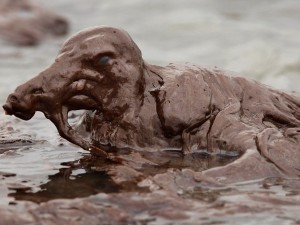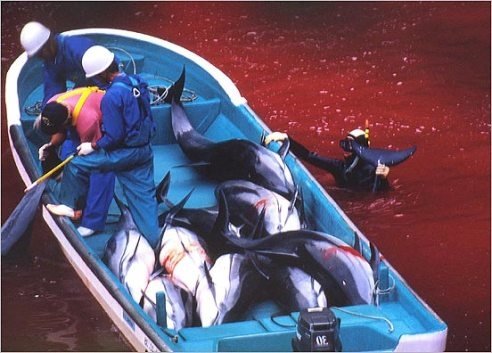From ANIMAL PEOPLE, September 2011:
Editorial feature:
Animal husbandry & the Horn of Africa famine

Cattle being led to watering hole in Southwestern Ethiopia.
By the editors of ANIMAL PEOPLE
“In central and western Kenya, farmers have had a bumper crop of plump ears of corn and earthy potatoes. Yet in the north, skeletal children wait for food aid amid a growing emergency,” recounted Katharine Houreld of Associated Press on September 1, 2011.
Altogether, Houreld wrote, 3.75 million Kenyans are at risk of starvation. Another eight million people are at risk in Ethiopia, Sudan, and Somalia.
Aid agencies, governments, and journalists have warned about the growing drought crisis in the Horn of Africa for more than two years, but few have better captured the paradox that the most afflicted nations–Kenya and Ethiopia–are still net food exporters, with thriving crop sectors despite the ecological and economic collapse of the Horn of Africa region.
“Small farmers in western Kenya–which has had steady rains and a good harvest–say they don’t move their crops to the drought-ravaged north because it costs too much to store and transport them and they are not assured of a market,” Houreld continued. “Many wouldn’t be able to afford to buy the produce in the north because the drought has killed their cattle. The pastoralist communities there use their herds like bank accounts, selling off animals when they need cash. Oxfam says in some areas between 60-90 percent of livestock have already perished.”
Overwhelming as is the human suffering in the Horn of Africa, animals brought into the world for human use have already suffered and died there in far greater numbers than the projected worst-case scenarios for people. Much of this misery was manufactured by aid agencies which should have known better. The present disaster has had ever more frequent precedents, each time followed by the same mistakes in helping the region recover. The first and greatest mistake, time and again, has been rebuilding animal husbandry.
Summarized The Economist in 2009, “The drought cycle in east Africa has been contracting sharply. Rains used to fail every nine or ten years. Then the cycle seemed to go down to five years. Now, it seems, the region faces drought every two or three years. The time for recovery–for rebuilding stocks of food and cattle-is ever shorter.”
The Economist mentioned “food and cattle” as separate commodities because this is the reality of the region. Despite the prominence of livestock in the culture and economy of the Horn of Africa, the residents eat less meat than the people of almost anywhere except India and Sri Lanka, where much of the population are vegetarian by choice.
Ethiopia ranks tenth in the world in cattle numbers, according to the United Nations Food & Agricultural Organization, with nearly three times as many cows as Kenya, yet Kenya produces 20% more beef. Including estimated consumption of poached wildlife, Ethiopians eat barely more meat and fish per capita than Indians and Sri Lankans. Kenyans eat about twice as much flesh food as Ethiopians, but Americans on average eat nearly 16 times as much as Ethiopians and eight times as much as Kenyans.
About 45% of Ethiopians and 30% of Kenyans, most of them in the Horn of Africa, were malnourished in recent non-drought years. Drought only intensifies the ongoing disaster.
The people of the Horn of Africa raise cattle and other livestock they cannot feed and water, and mostly cannot afford to slaughter until the animals are already dying, chiefly because livestock are their currency. They are as culturally wedded to livestock–including as the requisite price of arranging a marriage–as western cultures were wedded to the gold standard until 40 years ago, when then-U.S. President Richard Nixon uncoupled the value of the U.S. dollar from the price of gold.
The Horn of Africa may be the region where cattle were first domesticated. The Horn of Africa was not yet a desert when the pastoralist way of life evolved, close to 10,000 years ago. At that time, when humans were few, cattle and other livestock were an actual measure of wealth, indicative of the amount of meat and milk accessible to the people who kept them, and of the grasslands the herders could protect against predators and human invaders. But that was before millennia of overgrazing and deforestation induced the present aridity, before the numbers of animals the now impoverished herders keep came to mean little more than statistics in a bank book, and before continued reliance on animal agriculture plunged the region into both ecological and economic debt.
The most ominous aspect of the Horn of Africa crisis is that without a hard turn away from animal agriculture, climatic change suggests that the intensifying drought cycle will spread to almost the whole of Africa, hitting most severely the other nations, north and south, where the most people engage in animal husbandry.
“Currently, 1.6 billion people live in areas of physical water scarcity. This could easily grow to two billion soon if we stay on the present course,” warned the United Nations Environment Programme and the International Water Management Institute in a 2009 joint report entitled An Ecosystem Services Approach to Water and Food Security.
“Almost all of the Middle East, more than a third of Africa, and half of India are considered dryland,” UNEP and the IWMI explained. “This means that in these regions, on average, the amount of water evaporated from the Earth’s surface and transpired by plants exceeds rainfall. Drylands support one third of the global [human] population, up to 44% of all the world’s cultivated systems, and about 50% of the world’s livestock. Hunger, malnutrition and poverty are high in these areas.”
UNEP and the IWMI noted that historically “grazing animals capture the benefits of sparsely distributed rainfall by grazing on rainfed pastures” over large areas, but this was before the runaway human population growth that began in the 20th century.
“In recent decades,” the UNEP/IWMI joint report continued, “the expansion of cultivation along with the establishment of international boundaries and barriers across traditional migratory routes have diminished herd mobility and forced herders to adopt more sedentary livelihood strategies. The result has been an increase in severe land and water degradation and aggravated poverty, poor health and food insecurity. Unintentional trade-offs associated with livestock production include impacts on water scarcity, nutrient cycling, climate change and land degradation.”
UNEP and the IWMI were optimistic that “Opportunities exist for the sustainable management of livestock systems that maintain ecosystem services,” but only if “herders are able to get the same benefit from a smaller number of animals.” Hoped UNEP and the IWMI, “Management strategies to improve animal health and survival can reduce herd sizes.”
Some aid agencies have taken note, including Heifer International. Asks the Heifer International web site, after quoting the 2009 Economist article cited above, “Just two years later, the catastrophe is here. Will we hand out aid again and not dig deeper to long-term solutions? Will the images and stories fade until two years from now, when it all happens again, we’ll scramble to repeat the inadequate response?”
These are the necessary questions, but Heifer International offers an unviable solution, promoting more of the same mistakes that put the Horn of Africa into the present crisis.
“Heifer’s camel projects in Kenya and Tanzania have already helped farmers and pastoralists recover from loss of cattle,” the Heifer International site continues. “We’re studying ways to expand our model in Kenya to Ethiopia and Somalia.”
Introducing livestock better suited to a desertified climate, such as camels, may slow the rate at which animal agriculture becomes unviable. If fewer animals are kept, the habitat has more opportunity to recover from overgrazing. Indeed, the Heifer International model calls for “zero grazing.” But what “zero grazing” means is confinement husbandry, requiring that animals who formerly grazed must instead be fed crops.
Agricultural economists Muyeye Chambwera and Simon Anderson warned– abstractly–that this approach is unsustainable in an August 2011 briefing commissioned by the European Initiative for Agricultural Research for Development. “According to the Intergovernmental Panel on Climate Change,” Chambwera and Anderson wrote, “land area suitable for agriculture, length of crop growing seasons, and yield potential-particularly along the margins of semi-arid and arid areas-are all expected to decrease. National agricultural yields are likely to fall over the next 70 years. Africa’s population is expected to rise,” during this same time, “from one billion today to 2.1 billion by 2050.”
That combination of effects will not leave much crop production available for feeding confined livestock, regardless of species, or leave much land available for wildlife habitat.
Where are the animal charities?
One might expect international animal welfare organizations to be leading recognition that the epoch of animal husbandry in the Horn of Africa–and the rest of a hotter, drier world–is drawing toward a parched close. But so far there is little indication that any of the biggest animal charities have taken much note of either past experience or present realities.
“The poor pastoralist communities depend on animals for their livelihoods–for milk, for trade, for transport. Without animals their future is bleak,” contends the Society for the Protection of Animals Abroad, in disregard that keeping animals at enormous ecological cost has already deprived tens of thousands of humans and millions of animals of any future at all. Their bones are now bleaching in the African sun.
The Brooke Hospital for Animals and The Donkey Sanctuary are focused on providing aid to donkeys–but not in a manner likely to lastingly reduce donkey suffering.
Observed Brooke director of international development Dorcas Pratt in Mandera, Kenya, on August 19, 2011, “Water vendors are driving donkey carts through dusty streets, carrying water from the river. Less than 1% of the population of approximately 40,000 has piped water. A water truck serves institutions with sufficiently large water tanks and those able to afford its services. The rest of the population rely on donkey carts bringing water for drinking, cooking, bathing and washing clothes.” In El Wak, about 100 miles south of Mandera, Pratt added, “The Brooke and Practical Action have been contributing to purchase fuel for five boreholes in the drought stricken region, where owners and their donkeys drink and fetch water for the wider population.”
Certainly the donkeys who are alive and working today need water, as do the people. But expanding access to piped water and cisterns capable of holding a piped or trucked water supply would reduce the need for working donkeys, would provide jobs for displaced donkey drivers, and would have a noteworthy precedent, as one of the major projects of early humane societies in the U.S. and Europe was establishing pipe-fed water troughs in marketplaces.
Conceived and funded only to give thirsty working equines a drink where bringing water for them in buckets was impractical, these systems helped to introduce the notion of ever-available tap water, hastening the obsolescence of water-and-ice wagons. Several major humane societies still possess significant dedicated funds bequeathed to them for the extension of equine watering systems.
But instead of encouraging the replacement of working donkeys with non-animal powered technology, the Donkey Sanctuary is “gathering evidence to convince the humanitarian aid agencies that working animals, including donkeys, are necessary to the survival of agricultural communities.”
Says Donkey Sanctuary director of international operations Stephen Blakeway, “We want to see the official guidelines issued to these agencies altered to include provision for donkeys and mulesŠas well as providing essential transport for emergency supplies, donkeys are often used to plough once the rains return, in place of oxen who have starved to death.”
Tractors don’t starve to death, can be used in “no-till” cultivation which conserves water and prevents soil erosion, and just one well-maintained tractor could replace dozens of donkeys, at no more cost in fuel than the cost of running the pumps to water the donkeys from boreholes. So why is the Donkey Sanctuary perpetuating methods which keep donkeys enslaved, on the verge of starvation that fells oxen, and keep people–including children who miss getting an education–engaged in ecologically destructive and only marginally productive agricultural techniques?
“There is an unrealistic mindset amongst policy makers,” World Society for the Protection of Animals director general Mike Baker recently acknowledged to ANIMAL PEOPLE. “The question is not ‘How do we feed the increasing world population an increasing amount of animal products?’ but ‘How do we cope and adapt to the fact that we can’t do that?’
A western style consumption pattern at a global level with an increased population is pie in the sky. Only dramatic technology changes could deliver even anything close to that, and there are none out there that hold out any promise of that at the moment. The real message,” Baker said, “is that there needs to be a change of mindset.”
However, Baker contended, “‘Eat less meat’ is too simplistic a message, as meat consumption varies across the world. It would be a bizarre message in many parts of Africa,” such as the Horn of Africa, where meat consumption is low, “and does not deal with all of the issues,” Baker claimed. “We could have lower consumption and still have all of the animals confined in appalling systems. There are no models that can enable the world to adopt a western style consumption pattern,” Baker concluded. “We need to be there to help focus them on a new way of thinking and solutions that have at the very least the potential for good animal welfare and avoid a futile sacrifice of animals, environment and people’s livelihoods in a rush to industrialization.”
Applied to the context of the Horn of Africa, one might conclude that Baker sees the need to leave behind both unsustainable traditional pastoralism and the “zero grazing” confinement animal husbandry pushed by Heifer International –with which WSPA made common cause in at least one 2010 campaign. But the primary context of Baker’s remarks pertained to a recent WSPA appeal to “keep a wonderful tradition alive–the sight of dairy cows grazing in green fields.”
The declared object of the WSPA appeal is “to keep our dairy cows in fields, not in factories.” The appeal politically supports traditional elements of the British dairy industry who fear competition from mega-sized U.S.-style dairy operations, whose basic method is “zero grazing.” Yet picturesque and familiar as “the sight of dairy cows grazing in green fields” may seem to many WSPA donors, traditional British dairy farmers within recent decades brought the world mad cow disease by feeding calves “milk replacer” made from the bones of cattle, badger culls conducted in futile attempts to fight bovine tuberculosis (see page 6), the live export of calves to veal crating operations in Belgium and the Netherlands, and resistance to vaccinating cattle against foot and mouth disease, culminating in the mass slaughter of more than three million hooved animals before vaccination was accepted as inevitable.
Traditional British dairy farmers also often lease land to fox hunters, hare coursers, deer stalkers, and bird shooters, and have rallied several times in support of blood sports.
What WSPA is opposing is a trend which since 1995 has seen the numbers of British dairy farms decrease from 35,500 to 16,500, meaning a decrease by more than half in the numerical clout of dairy farmers, while the average milk yield per cow has increased by 19%. Thus 600,000 fewer cows are needed to produce the British milk supply, meaning a 24% decrease in the number of calves born each year to be exported for veal or be fed “milk replacer” before being slaughtered for beef or being impregnated and put into milk production.
On balance, despite the objectionable aspect of “zero grazing,” it is difficult to argue that a 24% reduction in the numbers of animals subjected to the cruelties associated with the dairy industry as practiced on any scale is anything other than a net gain for animal welfare.
Whether in the Horn of Africa, Britain, the U.S., or anywhere else, animal husbandry is both ecologically and ethically unviable. Arid regions may be able to support their human population, but not by feeding and watering livestock. The U.S., Europe, and parts of Asia which have long sustained animal husbandry with the help of melting glaciers and undergound aquifers are also running critically short of water, and will also have no choice but to eventually reduce animal consumption–as some livestock industry experts already recognize. Texas AgriLife Extension Service state forage specialist Larry Redmon, for example, in mid-August 2011 advised drought-stricken ranchers to “just get out and come back later,” if and when adequate water is again available.
“It’s unprecedented,” Redmon acknowledged. “We’ve had the 12 driest months in Texas history, and there’s just not many ways to combat that.”
The question before us is whether animal advocates will step forward to demonstrate viable alternatives to animal husbandry, especially where they are most urgently needed, or will continue to pretend that watering donkeys and keeping dairy cows in fields represents adequate leadership.
¶
ADVERT PRO NOBIS
________________________________________________________________________________________________________
IF YOU THINK THE LAMESTREAM MEDIA ARE A DISGRACE AND A HUGE OBSTACLE
to real change in America why haven’t you sent at least a few dollars to The Greanville Post (or a similar anti-corporate citizen’s media?). Think about it. Without educating and organizing our ranks our cause is DOA. That’s why our new citizens’ media need your support. Send your badly needed check to “TGP, P.O. Box 1028, Brewster, NY 10509-1028.” Make checks out to “P. Greanville/ TGP”. (A contribution of any amount can also be made via Paypal and MC or VISA.)

THANK YOU.
____________________________________________________________________________________________________





